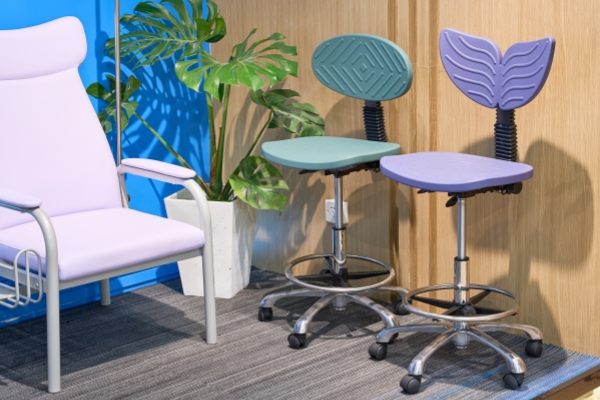In high-precision environments such as electronics manufacturing, semiconductor manufacturing, medical equipment, and laboratories, ESD chairs (anti-static chairs) are a crucial component in maintaining a stable anti-static control system. Many companies focus solely on appearance and price when purchasing, overlooking key certifications and technical details. This results in high investment, poor results, and frequent maintenance. This article will provide a comprehensive guide to avoiding ESD chair purchasing pitfalls, helping companies avoid common mistakes and select products that truly meet international standards.
1. Pitfall #1: Ignoring Core Certifications, Leaving Anti-Static Performance a "Castle in the Air."
Many buyers only care about whether a chair is "conductive," but overlook the authoritative certifications verifying its performance. Certification is a key indicator of whether an ESD office chair or industrial anti-static chair meets the requirements.
Key to Avoiding Pitfalls: Identify These Two Core Certifications
a. ANSI/ESD S20.20 Standard Certification
What is this? This is a globally recognized standard for electrostatic protection systems developed by the American Electrostatic Discharge Association. If the ESD chair you purchase claims to comply with this standard, it means the manufacturer's production system and quality control ensure that the product consistently and reliably meets anti-static requirements.
How to verify this? Request a test report from the supplier confirming that the product's resistance value is within the effective range specified by the standard (typically 10^6 to 10^9 ohms).
b. Product Resistance Test Report
What is this? This report measures the actual resistance of key components of the ESD chair, such as the seat cushion, backrest, and frame. A qualified report clearly displays the point-to-point resistance and resistance to ground of each component, ensuring that static electricity is discharged smoothly and safely to the ground.
How to verify this? Be sure to review the report issued by a reputable third-party testing agency to ensure the data is reliable. Never trust verbal promises.
2. The second pitfall: Focusing solely on the chair surface and ignoring overall conductivity.
A qualified anti-static chair is a complete static discharge path. If any link is not conductive, the entire system will fail.
The key to avoiding pitfalls: Examining the complete path from person to floor.
Seat material: High-quality ESD chairs use specially treated PU or fabric with conductive threads woven into the fabric to effectively conduct static electricity when in contact with the human body.
Foam and chassis: The seat foam must be conductive, and the chair's lift chassis (gas rod) must also be ESD-specific to ensure smooth current flow.
Five-star feet and casters: This is the final step in connecting to the floor. Five-star feet on ESD chairs are typically made of conductive nylon, while casters are made by adding conductive carbon black to regular casters to ensure a complete circuit when in contact with the anti-static floor.
When purchasing, always ask, "Are all components of this chair conductive?" and request an on-site demonstration or proof of overall resistance testing.

3. The third pitfall: Confusing the concepts of "anti-static" and "dissipative."
Many people believe that ESD chairs are designed to quickly discharge static electricity, but this is not the case. The key to static control is "smooth, slow discharge," not instantaneous discharge, which can also damage delicate electronic components.
Key to Avoiding Pitfalls: Understanding "Static Dissipation"
A true industrial ESD chair is made of "static dissipative" material, with a precisely controlled resistance between 10^6 and 10^9 ohms. This resistance ensures effective conduction of static electricity while preventing the risk of sparks from rapid discharge. When purchasing, make sure you require a "static dissipative chair," not just a "conductive chair."
4. The Fourth Pitfall: Sacrificing Durability and Ergonomics, Leading to Soaring Hidden Costs.
While strictly controlling the price of an ESD chair, never compromise its fundamental properties as a "chair."
Key to Avoiding Pitfalls: Pay Attention to These Durable and Comfortable Details
Gas Rod Quality: Choose Class 3 or Class 4 gas rods that meet BIFMA (National Furniture Association) testing standards for increased safety and a longer lifespan.
Chassis Strength: Inquire about the thickness and material of the chassis. A heavy chassis ensures long-term stability.
Ergonomic Design: For positions requiring prolonged sitting, choosing an ergonomic ESD chair with an ergonomic lumbar support, adjustable height, and armrests can significantly improve employee comfort, reduce occupational injuries, and ultimately boost productivity. This investment in health is far more cost-effective than subsequent medical costs and employee turnover.
Caster Material: Choose according to floor conditions. For epoxy or anti-static floors, use an ESD chair with PU wheels, which are soft, durable, and gentle on the floor. For rough concrete floors, a more durable material may be required.
5. Buying Checklist: Helps you choose the right ESD chair in one stop.
In summary, when purchasing ESD chairs wholesale or individually, be sure to use this checklist when screening suppliers:
Certification Required: Requires a product test report per ANSI/ESD S20.20.
Path Testing: Confirm that the entire path from the chair seat to the casters is conductive.
Check the resistance value: Ensure the product's resistance is within the "static dissipation" range of 10^6-10^9 ohms.
Durability: Check the quality and certification of structural components such as the gas boom, chassis, and casters.
Comfort: Choose a model with appropriate ergonomic design based on employee work hours.